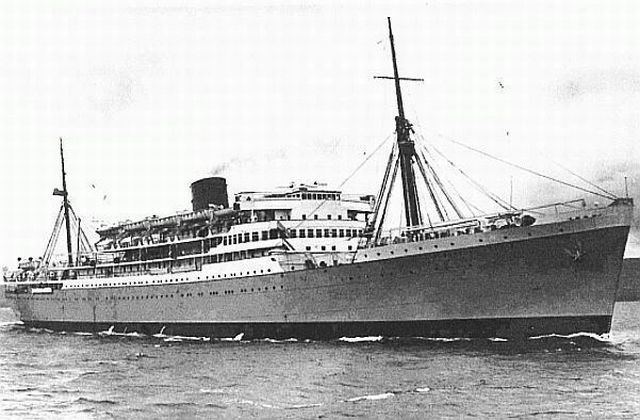Yard number 959 Completed 27 June 1936 Construction started 1935 Draft 6.77 m | Laid down 1935 Maiden voyage July 1936 Launched 25 January 1936 Builder Harland and Wolff | |
 | ||
Name Dunnottar Castle (1936-1958)Victoria (1958-1975)The Victoria (1976-1993)Princesa Victoria (1993-2004) Operator Union-Castle (1936-1958)Incres SS Co (1958-1964)Clipper Line (1964-1975)Chandris Lines (1975-1993)Louis Cruise Lines (1993-2004) | ||
Ms dunnottar castle or ms princesa victoria 1936 2004
The MS Dunnottar Castle was the original name of a twin-screw passenger ship built in 1936 and more widely known under her later name Victoria or The Victoria. Victoria was a cruise liner first operated by the Incres Steamship Co and later by Chandris Lines in the Caribbean Sea. Victoria was sold to Louis Cruise Lines in 1993 which operated the ship as Princesa Victoria until it was scrapped in India in 2004. Victoria retained a classic liner look with several features unchanged since her pre-war construction for her entire operational life.
Contents
- Ms dunnottar castle or ms princesa victoria 1936 2004
- Construction and war service
- Career as cruise liner
- Final years
- References
Construction and war service
The ship was originally built by Harland & Wolff of Belfast in 1936 as the Union-Castle liner Dunnottar Castle. She had a gross tonnage of 15,054 tons. She departed on her maiden voyage from Southampton to Cape Town in July 1936. Upon her return, she commenced her regular service, Tilbury (London) - Africa, serving as supply ship for St. Helena.
At the outbreak of the war, Dunnottar Castle was converted into an armed merchant cruiser by the Royal Navy. She departed on her first tour of duty on 14 October 1939. In 1942, she commenced duties as troop ship until 1948, when she was decommissioned from Naval service. She immediately received a comprehensive overhaul and resumed her London to Africa service in 1949, which continued for the next nine years.
The ship played a small part in the search for the coelacanth; the telegram from Captain Hunt to Dr JLB Smith noting the discovery of the second coelacanth in the Comoros reached him when the ship stopped in Durban on 24 December 1952. All of his scientific gear was deep in the hold of the ship.
Career as cruise liner
Dunnottar Castle was bought by Incres Steamship Co in 1958 and substantially refitted as a cruise liner at the Wilton-Fijenoord shipyard near Rotterdam. The ship received a new engine, new superstructure and a new raked bow, changing her overall appearance significantly. The first and tourist class cabins were reconstructed into 600 single-class cabins with private facilities and air-conditioning. Incres renamed her Victoria and ran her out of New York City on West Indies cruises
In 1964, she was sold to Victoria SS Co Monrovia, a subsidiary of Swedish company Clipper Line from Malmö. She retained both her name and service. Incres Line continued as agents for the ship. For eleven years, Victoria made cruises from the United States to the Caribbean.
In 1975, the company sold her to Chandris Lines and she ran on Caribbean and European cruises until 1993 with a minor refurbishment in 1987. It was in 1987 that Jade deck was created by converting storerooms into thirty eight (38) passenger cabins. This was a major feat as the ship was cruising with passengers on board at the same time.
Final years
The ship's final incarnation was as the Princesa Victoria making 2 and 3-day cruises from Cyprus under the ownership of Louis Cruise Lines. During the winter seasons, Princesa Victoria was laid up in Perama. She was used as a shore-side hotel-ship for Expo '98 and for the G8 summit in Genoa in 2001.
Finally, the ship was laid up in 2002 and broken up in 2004 at the Kumar Steel Breakers Yard in India. At the time, she was the oldest large liner still operating anywhere in the world.
